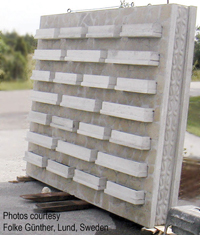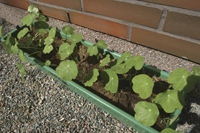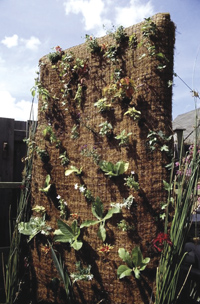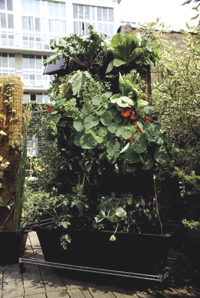Growing Up and Down
by Wendy Priesnitz
Vertical gardens – both indoors and outside – save space, create privacy, reduce dust, remove air pollutants, insulate against temperature extremes and noise and enhance biodiversity. Not bad for a style of planting that’s been popular for centuries.
From the hanging gardens of Babylon to ivy covered university halls, we have long enjoyed growing plants on walls and fences. The practical and aesthetic benefits are many, encouraging both individual gardeners and eco-aware architects to create new incarnations of the vertical garden.
Vertical gardens can range from a simple “wall” of hanging plants used to provide shade, privacy, and visual pleasure in a backyard, on an apartment balcony, or even indoors, to an elaborate perpendicular hydroponic system designed to purify the air and provide a natural interface for occupants of a large commercial building.
Growing vertically maximizes the use of space in tight locations, improves ambient air quality, provides a unique visual element and/or privacy and reduces thermal loading of sun-lit walls during summer. More sophisticated vertical gardens can, when connected to rain barrels or cisterns, help purify rain or grey water. As well as saving water, they can save maintenance time when all the plants are watered simultaneously and/or automatically.
In a presentation earlier this year to the Greening Rooftops for Sustainable Communities Conference in Boston, Massachusetts, Dr. Manfred Koehler of the University of Applied Sciences in Neubrandenburg, Germany noted that vertical gardens can be found in the literature stretching back several thousand years to the Mediterranean regions. There, they were used primarily for shade and the production of fruit. During the Middle Ages in Central Europe, grapes were commonly grown on castle walls for wine production. He also described how, more recently in Germany, some of the first research on vertical gardens was conducted as part of the urban ecology movement. Koehler’s research has shown a number of benefits to vertical gardening, including a four percent reduction of annual dust fall; helping to remove these particulates and car exhaust from city air; removal of specific air pollutants, such as copper, chromium and aluminum; and up to 25 percent savings in energy on north facing facades.
Many European countries have public policies in place to encourage the use of vertical and rooftop gardens in urban areas. In Sweden, for, instance, farmer and field biologist from Stockholm University Folke Günther has had success with his “folkewall” (pictured right), made from two large (2 x 2.5 meter) plates of concrete. The plant growing pockets are inserted in holes in the concrete. Water enters from the top and trickles down.
To investigate the application of green walls and roofs in Canada, Environment Canada and several private sector partners recently completed a report on the benefits of rooftop and vertical gardens, entitled Greenbacks from Green Roofs: Forging a New Industry in Canada, for the Canada Mortgage and Housing Corporation.
Researchers Steven Peck and Chris Callaghan of Peck and Associates, architect Monica Kuhn and Dr. Brad Bass of Environment Canada found that vertical greening has all the benefits of green roofs, but the potential positive impact is greater, since the greening of a building’s facade often encompasses four times the area of the roof and even more for a highrise building.
According to the report, one of the chief benefits of planting vegetation on buildings is to reduce energy usage and therefore greenhouse gas emissions. They found that by protecting buildings from wind, plants can reduce heating in winter by 25 percent and, through direct shading and evaporative cooling, air conditioning in summer can be reduced by 50 to 75 per cent. A 16-centimeter thick blanket of plants can increase the R-value of a wall by as much as 30 percent.
Wall and rooftop gardens also regulate the “urban heat island,” a phenomenon that causes cities to be up to eight degrees C warmer than the surrounding countryside due to re-radiated heat. Through evapo-transpiration, a layer of vegetation can reduce the amount of re-radiated heat on a hot summer day by up to 90 percent, thereby reducing the urban heat island by three to four degrees.
Greening Corporate Interiors
The lush interior plantings increasingly found in large corporate buildings have taken vertical gardens indoors. For a few decades now, Toronto biologist Wolfgang Amelung, through his company Genetron Systems Inc., has been creating miniature indoor ecosystems using vertical plantings and water features. In the mid-90s, he began to install large corporate applications, including biofiltering “breathing walls” at the Toronto corporate headquarters of Canada Life Assurance Company, Panasonic and Club Monaco.
In these installations, water flows over a lava rock wall covered by moss and other plants, then into a small pond. Contaminants in the air are absorbed by the vegetation and consumed by micro-organisms in the soil. Any excess waste is carried to the pond, where it is eaten by fish, frogs or insects. There are 400 plant species and up to 60 animal species (mainly fish, small amphibians and some insects) in the ecologically complex and stable biological community that is the Canada Life installation.
A team of researchers from the University of Guelph (U of G) evaluated the wall’s potential for mitigating poor indoor quality. In controlled tests, the breathing wall was found to be capable of removing between 50 and 80 percent of some contaminants introduced to the system. They also found that in addition to improving air quality, the wall is esthetically pleasing, which has the potential for producing a positive psychological effect on the occupants of the building.
Academic institutions are also discovering the benefits of interior vertical gardens. A 170,00 square-foot building at the University of Guelph uses a lush wall of plants growing in its atrium as a living air purifier. The four-story biofilter is a thick jungle of ferns, ivy and other plants, which emit microbes that break down harmful airborne contaminants into water and carbon dioxide. Research at U of G has shown that the system can remove half of the benzene and toluene in the air during a single pass and up to 90 percent of the formaldehyde.
The biofilter was developed by biological researchers at the University of Guelph, including Alan Darlington, a graduate of who now heads his own company, Air Quality Solutions, Ltd., which sells the living walls commercially. The wall naturally generates fresh air, reducing the need for ventilation, heating and cooling. Engineers estimate that up to 3.5 kilowatts per person can be saved during peak seasons.
Darlington and his graduate supervisor Professor Mike Dixon were among those studying the biofiltration system in the early 1990s on the vertical garden at the Canada Life Assurance Building in downtown Toronto. His company’s installations also include ones operating at Queen’s University, at the headquarters of the Toronto and Region Conservation Authority and in the Richardson Building, a private office in downtown Toronto.
Walls of Art
Some of the largest and most artful vertical gardens can be found in Paris, France. They are the work of Patrick Blanc, who has grown plants on walls for 40 years. As a teenager, Blanc was inspired by the tropical rainforests of Malaysia and Thailand and, in 1988, he patented the technique for growing vertical gardens that he had started developing as a child. It involves rooting plants in non-biodegradable felt stapled to plates of PVC affixed to a metal scaffolding. Fertilizer is fed through a hydroponic drip irrigation system located at the top of the wall.
In 1994, Blanc introduced his vertical gardens to the International Festival of Gardens at Chaumont-sur-Loire. After that, commissions started to pour in. He is now a scientist at the French national research agency (CNRS) in Paris, and an expert on shade-dwelling plants of tropical forests. But his vertical garden installations also reveal him to be an artist. He creates a rich and exuberant variety of images on his living tapestries, simply by arranging diversely colored plants on the walls.
Blanc’s murs végétals (vegetal walls), drawing from the plant communities that thrive on wet vertical rock surfaces in nature, appear in almost a dozen different interior and exterior locations in and around Paris, from private residences and stores to the Musée du Quai Branly, which comprises a total of 15,000 plants in an artistic configuration.
Emilio Ambasz is an architect based in New York City who also favors vertical gardens. His plantings play a significant role in the recent expansion and renewal of the Buenos Aires Museum of Modern Art and Cinema, in the Argentinian capital. The vertical garden creates a kind of screen which, as well as concealing the older part of the building and its deteriorated facade, protects the areas used for the galleries. In a presentation to the Greening Cities conference in Australia in 2002, Ambasz spoke of striving for an urban future where one can open the door and walk out directly onto a garden, regardless of how high their office or apartment may be. He said there is a need within a high density city to reconcile our need for building shelters that meet our emotional requirement for green spaces.
Vertical Farming
Growing vertically can be seen from another perspective, as illustrated by the concept being promoted by a professor at Columbia University’s Department of Environment Health Sciences. Dickson Despommier talks about the possibility of vertical farming in the urban environment as a way to obtain an abundant global food supply without converting any more fragile ecosystems into farmland. By that, he means not necessarily growing food on a wall, but in a sort of highrise greenhouse format. He says that if traditional farming could be replaced by constructing multi-story urban food production centers, which he has dubbed “vertical farms,” we could see the gradual repair of many of the world’s damaged ecosystems through the systematic abandonment of farmland.
In a paper published by The Vertical Farm Project, Despommier enthuses, “The vertical farm should be a thing of architectural beauty as well as be highly functional, bringing a sense of pride to the neighborhoods in which they are built. In fact, the goal of vertical farm construction is to make them so desirable in all aspects that every neighborhood will want one for their very own.”
On a much smaller scale, many urban home gardeners are already able to grow an abundant supply of produce on a small plot of land. They use trellises, nets, strings, cages and poles to support growing plants, sometimes combined with raised beds. Some plants will twine themselves onto the support, whereas others require tying. Plants grown vertically take up much less ground space, and though the yield per plant may be less, the yield per square foot is much greater. Because vertically growing plants are more exposed, they dry out faster and require more water than if they were spread over the ground. However, this fast drying is advantageous to plants susceptible to fungal diseases.
So whether it’s to purify the air, grow some food, or just decorate your surroundings, try planting a wall!
Wendy Priesnitz is Natural Life Magazine's co-founder and editor. She is a journalist with 40 years of experience and the author of 13 books.
|

Do-it-Yourself
Vertical Gardening
Start with a simple trellis made of wood, iron or even wide mesh wire. Place it wherever you want to screen out an undesirable view. If you’re creating a pole-bean tripod or flower trellis, hammer your stakes into the soil at least six inches deep. But if you’re growing an aggressive climber or one with heavy fruit or vegetables, cement the posts in the ground or firmly fasten the structure to a wall.
Plant fast-growing vines or espalier trees at the base, either directly in the ground or in pots with drainage.
Good native vine selections include trumpet creeper (Campsis radicans), Virginia creeper (Parthenocissus quinquefolia), passionflower vine (Passiflora lutea), Dutchman’s pipe (Aristolochia macrophylla), and native wisteria (Wisteria frutescens.) Avoid invasive ivy!
Outdoor vertical garden systems can support edible plants like Romaine lettuce, vining cucumbers, kale, cabbage and cherry tomatoes. For an attractive display, the vegetables can be interspersed between species of flowering plants, and ferns, spider plants, lilies, palms, ficus and even strawberries. Pole beans can be grown on a trellis, as can small squash and pumpkins, providing they’re supported in well-anchored slings made from old t-shirts or pantyhose.
An alternative to a trellis is to fasten a strong board horizontally near the top of the wall (using concrete nails into the mortar if the wall is brick), then hang pot braces and chains from that support.
Try hanging one pot beneath another for an easy tower effect; repeat the color or contrast it, use the same size or graduate up from large to small. Given the right environment (i.e. surroundings that can take some water splashing or spillage), remove the drainage saucers from the upper pots so water can drain from one to another, thereby conserving water on your tower.
Your garden center may sell plastic tubular-shaped bags with planting holes on all sides. Add soil to the level of the first hole, put in a plant, then add soil to the second hole and plant that one. When they grow together, the result can be a blooming flower column, or a hanging herb garden.
Include bird feeders in your backyard vertical garden. Sink a sturdy pole into a hole filled with concrete. Then attach two-by-four wooden arms to hold a collection of feeders and welcome a host of birds to your garden.
Other accessories to include on your wall could include wind chimes, gargoyles, terra cotta sun faces, decorative plaques, found objects and small shelves.
These ideas can be easily adapted to create an indoor vertical garden with the correct choice of plants and pots.


Above: Before and after photos of a wall of plants in a coconut growing medium. They are designed by Brad Peterson, a Canadian pioneer in the design and use of vertical gardens. His Vertical Gardens come in three basic forms: tubes, coconut-cylinders or walls. All are designed to be easily moved indoors or outdoors as desired.
Photos courtesy Brad Peterson Environmental Management and Landscape Architecture
For an update to this article, see "Growing Up".
|

